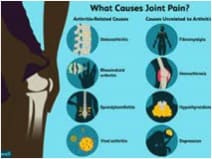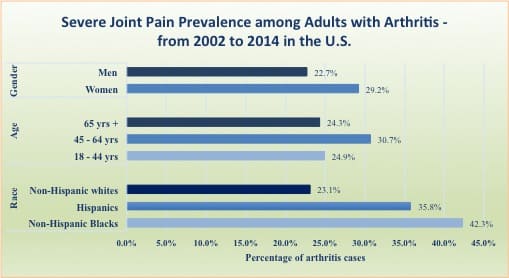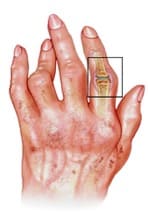Joint Pain
14
July
2021

What is joint pain?
Joint pain is one of the most common types of pain felt because the joint is a form that connects bones and provides support to them during movements. Meaning that with more movements happening, the probability of suffering from an injury or a disease that leads to a damaged joint becomes higher. This damage and pain that happens in the joints interferes with everyday movements and activities and makes them more difficult to accomplish. According to NHS (2019), “in older people, joint pain that gets steadily worse is usually a sign of osteoarthritis. It may affect just one joint or many.” Therefore, we will be looking for potential joint pain causes that affect either one or many joints.
What are the causes of joint pain?

-
In general:
-
Arthritis
The most common cause of joint pain is arthritis. Arthritis is the swelling and tenderness of joints that lead to pain. The two main forms of arthritis are osteoarthritis (OA) and rheumatoid arthritis (RA).
This condition is more likely to occur with adults who are over the age of 40. (Healthline, 2019)
The reason behind this is that arthritis evolves the more the person moves their joints and the more sensitive they become. It affects mainly the wrists, hands, hips, and knees.
Osteoarthritis happens after the cartilage of the joint breaks down. The cartilage is a form of cushion for the joints that absorbs shock, and after it breaks down, it leads to severe pain in the joint area.
Rheumatoid arthritis is a deformation of the joints that occurs over time. It leads to an inflammation and a fluid buildup in the joints, which in itself leads to extreme pain and discomfort. “It more commonly affects more women than men.” (Healthline, 2019).
Here is a study done by the CDC showing some facts about arthritis in the United States of America, between 2002 and 2014.
-
-
Causes of pain in just one joint:
-
Knee pain:
The knee is one of the most sensitive and vulnerable places in the body because it holds the entire body weight, which means that the knee joint is damaged very frequently. Not all knee pains are joint problems, but most of them are.
-
Inflammation of the joint lining:
This condition occurs when a joint has been injured recently, and then it becomes painful again. This is a condition called traumatic synovitis meaning that the thin layer of tissue that lines the joins and tendons together is infected. It only leads to pain without any redness, tenderness or heat and should be healed easily with anti-inflammatory medicines and rest.
-
Gout or pseudogout:
Gout and pseudogout are two types of arthritis. Gout affects the joint of the big toe then affects the rest; meanwhile pseudogout affects the knee joint at first. The treatments differ from one to the other, which is why it is important to correctly diagnose which pain you are feeling. They both lead to a red and hot skin with repeated attacked pain that comes and goes.
-
Damage to the cartilage at the back of the kneecap:
This condition is also a knee pain that is diagnosed by a discomfort in going up and down the stairs. It’s called chondromalacia patellae and in easier terms, it’s called a damaged knee. This happens because of using the knee too much, and it leads to joint pain that comes without any redness or heat. It is treated with anti-inflammatory medicines and rest.
-
Bleeding into the joint space:
Any recent injury in the joint area might cause bleeding in the spaces and tissues that cover the joints. Symptoms of this condition are the swelling of the injured area, its warmth, its stiffness, its bruising, and the extreme pain that occurs.

-
-
Less common causes:
There are other causes that lead to pain in one joint, but they are very rare:
Fractures: broken arm, leg, wrist… that lead to joint problems and pain.
Reactive arthritis: it’s a type of arthritis that affects young adults after an infection.
Psoriatic arthritis: it’s a type of arthritis that affects people with psoriasis.
Osgood-Schlatter’s disease: a swelling and tenderness of the area below the kneecap.
Cancer.
Crumbling of the bone.
Dislocation of the joint.
Hemophilia: an illness that is inherited genetically.
-
Causes of pain in many joints:
-
Rheumatoid arthritis:
As mentioned earlier, arthritis in general and rheumatoid arthritis in particular are one of the most common causes of joint pains. But it is important to bring up RA again in this case because it not only affects one joint but leads to pain in many joints at the same time. It also leads to swelling, and occurs mainly in the hand, feet, and wrist areas. At first, the pain comes and goes, but after a while it attacks the whole immunity system and “it can make you feel generally unwell and tired.” (NHS, 2019)
-
Psoriatic arthritis:
According to NHS (2019), “psoriatic arthritis affects up to 1 in 5 people with psoriasis.” Psoriatic arthritis is a type of arthritis that affects people with psoriasis; it is very unpredictable but sometimes could be controlled with treatments. Just like other arthritis types, the symptoms are inflammation, stiffness, pain, difficulty to move, and swelling. Many viral infections can also lead to arthritis like viral hepatitis and rubella. And some diseases could increase the pain in this case, such as:
Lupus: A condition where the body’s immune system mistakes healthy cells for dangerous ones and attacks them.
Scleroderma: A condition where the immune system attacks tissues which are under the skin and hardens them more.
-
Less common causes:
Less common causes that occur rarely but could lead to pain in many joints are:
Rare types of arthritis such as ankylosing spondylitis, juvenile arthritis, or reactive arthritis.
Rare treatments that include taking steroids or hydralazine.
Behçet syndrome: a condition that leads to the infection of blood vessels.
Henoch-Schoenlein purpura: a very rare condition close to behçet syndrome but that occurs mostly in young children.
Hypertrophic pulmonary osteoarthropathy: a rare condition that occurs in people with lung cancer. It leads to the clubbing of the fingers.
Sarcoidosis: a rare condition that leads to the formation of tissues in the organs.
Cancer.

-



How to treat joint pain?
There are many types of joint pain; it could vary from mild pain to extreme pain. Joint pain could be short term, which heals alone, or long term, which requires special type of treatments and care. Both types of pain should be diagnosed by a professional doctor and should be taken seriously. Joint pain relief treatments are mostly:
-
Medications:
Taking medications is a very direct and common treatment to joint pain, especially moderate to severe joint pain that comes with swelling. To add, if the area is infected, taking anti-inflammatory medicine is very necessary. Other types of medications used are muscle relaxants to relax the spasms in the joints and muscles, and some antidepressant drugs to interfere with pain signals. Keep in mind that all medicines have side effects and could affect each person differently, which is why it is important to go see a professional and seek for their recommendation.
-
Injections:
When the patient does not heal from medications, doctors usually prescribe injections. There are many types, they vary between:
Steroids: The most common injection is steroid that is injected directly into the injured joint every 3 to 4 months. They are common for people who suffer from arthritis and never used their joint after an injury because then the person might hurt it even more. It might remove the pain at first, but the aftereffects might be way worse.
Platelet-rich plasma therapy: This therapy, also known as PRP, is the concept of injecting one’s own blood into his painful joint. This will increase infections because of the platelets and proteins injected, and will remove the pain.
Prolotherapy: This is an injection of an irritant which is mostly a sort of sugar solution in the joints. It heals all the tissues, ligaments, and tendons around it and relieves the patient from the pain.
Hyaluronan injection: This is an injection of the natural joint fluid. It is used for people who suffer from osteoarthritis.
Finally, there is an injection that removes the fluids from the joints that has shown to be effective.

-
Physical Therapy and Home Care:
Physical therapy helps heal all bone and joint related problems. To add, exercising is also a way of treating joint pain by losing some weight and relieving the joints of some pressure. Swimming, bicycling, and other low-impact exercises also lead to healthier and stronger joints without putting impacts on them. Finally, there are many home care tips a person can use to treat himself from joint pains. For instance, resting the joint and avoiding any harmful activities helps the joints a lot. To add, compressing the joint several times a day for a couple of minutes then elevating it helps it become stronger. And finally, putting ice or heating pads on the injured area helps ease the swelling and the pain, but according to WebMD (2021), “avoid keeping the joint still for too long because it can eventually become stiff and lose function.”
If you or anyone you know is suffering from pain, call us today on (469) 562 4188 to book an appointment with our expert doctors.